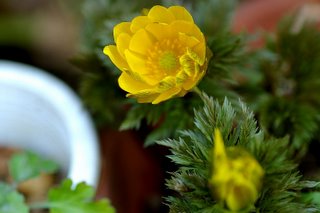:::::::::::::::::::::::::::::::::::::::::::::::::::::::::::::::::::::::::::::::::::::::::::::::::::::
Pheasant's Eye (fukujusoo, Japan)
***** Location: Japan
***** Season: New Year
***** Category: Plant
*****************************
Explanation
Pheasant's eye, fukujusō, 福寿草
New Year's Day Plant,
... ganjitsusoo, ganjitsusō 元日草
... tsuitachisoo 朔日草
Adonis amurensis, Family: Ranunculaceae. Crowfoot
Adonis annua
Grows in many mountainous areas of Japan. It begins to show new leaves in February or March and flowers with small bright yellow blossoms of 10 to 20 petals with a strong glow. Since the flowering time fell in the New Year season according to the lunar calendar, it was used as a decoration for the New Year, hence the name.
Even now some farmers grow it especially to flower for the First of January.
In the Edo period, it was already artificially grown and sold in small pots, with petals of white, cream and red flowers, even double-petals (yae 八重咲き).
The name actually means : Plant of good fortune and long life, "prosperity grass" or "longevity grass", so it was very auspicious for the New Year celebrations.
Gabi Greve
xxxxxxxxxxxxxxxxxxxxxxxxxxxxx

http://www.dynax.co.jp/sinsen/photo/hana_koyomi/gf_fukujyusou.html
xxxxxxxxxxxxxxxxxxxxxxxxxxxxx

Great page with photos
http://aoki2.si.gunma-u.ac.jp/BotanicalGarden/HTMLs/fukujusou.html
*****************************
Worldwide use
Amur-Adonis-Röschen
Adonis amurensis
Frühlings-Adonisröschen
Adonis vernalis
*****************************
Things found on the way
*****************************
HAIKU
大雪をかぶって立や福寿草
ôyuki o kabutte tatsu ya fukuju kusa
covered by the big snow
yet they stand...
New Year's grasses
Issa
(Tr. David Lanoue)
Haiga by Nakamura Sakuo

http://blog.livedoor.jp/sakuo3903/archives/50332688.html
:::::::::::::::::::::::::::::::::::::::::::::::::::::::::::::::::::::::::::::::::::::::::::::::::::::
朝日さす老師が家や福寿草
asahi sasu rooshi ga ie ya fukujusoo
morning sunshine
on the old Zen teacher's home -
Pheasant's eye in bloom
Buson 与謝蕪村
Tr. Gabi Greve
:::::::::::::::::::::::::::::::::::::::::::::::::::::::::::::::::::::::::::::::::::::::::::::::::::::
地面から宙がはじまる福寿草
jimen kara sora ga hajimaru fujukusoo
from the earth
the sky begins ...
Pheasant's eye
Miyasaka Shizuo 宮坂静生 (1937 - )
He taught the NHK haiku lessons for two years.
:::::::::::::::::::::::::::::::::::::::::::::::::::::::::::::::::::::::::::::::::::::::::::::::::::::
日のあたる窓の硝子や福寿草
hi no ataru mado no shooshi ya fukujusoo
the sun shines bright
on the window panes ...
Pheasant's eye
Matsui Kafuu 永井荷風 (1879 - 1959)

Photo
http://blog.goo.ne.jp/akiiys/e/12c83638afc11a6eaff747a5e925cff1
*****************************
Related words
***** Fern and the Seven Herbs of Spring
Kigo for the New Year
SAIJIKI – THE NEW YEAR
:::::::::::::::::::::::::::::::::::::::::::::::::::::::::::::::::::::::::::::::::::::::::::::::::::::

植木福寿草売り
Women Buying Potted Plants from a Street Vendor
Torii Kiyonaga 鳥居 清長 (1752–1815)
. Edo Culture via Ukiyo-E .
- Join us on facdbook -
:::::::::::::::::::::::::::::::::::::::::::::::::::::::::::::::::::::::::::::::::::::::::::::::::::::
[ . BACK to WORLDKIGO TOP . ]
[ . BACK to DARUMA MUSEUM TOP . ]
:::::::::::::::::::::::::::::::::::::::::::::::::::::::::::::::::::::::::::::::::::::::::::::::::::::







2 comments:
Gabi san
有難うございます。
いろんな福寿草で楽しいですね。
これらの福寿草を見ていると本当に
春が待ちどうしい気になります。
sakuo
Gabi san, I enjoyed these photos and Sakuo's haiga.
Your Pheasant flower must be related to our winter aconites?
Here's a Canadian photo:
http://www.uoguelph.ca/arboretum/PhotoGall/PhotoFlower10.htm
And here's one with the full name (and ultra violet light!)
http://www.naturfotograf.com/UV_ERAN_HYE.html
I had them in one of my gardens, many years ago...
:~)
Canada
::::::::::::::::::::::::::::::::::::::::::::::::::::::::::::::::::::::
Post a Comment